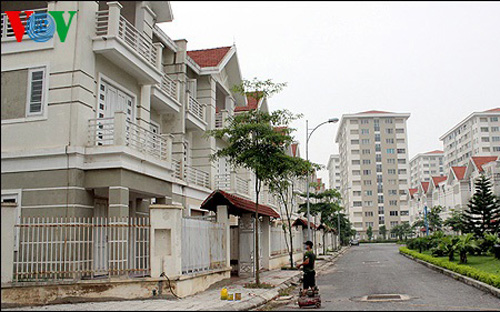Measures to prop-up real estate market

Deputy Minister of Construction Nguyen Tran Nam emphasizes that unstable capital sources have caused major hurdles for the real estate market.
Unstable credit loans for real estate investors
Deputy Minister Nam says many countries have their own separate financial system for the real estate sector to best accommodate long-term investment in real estate projects adding that, there is not such channel in Vietnam.
Vietnam’s funding market is heavily skewed toward the short term, driven by customers who see bank savings tools mainly as a way to hold and invest their funds for the short term.
This creates a high risk of a national liquidity crisis as insufficient funds are available for long term real estate projects when bank deposits are invested by customers primarily for the short term.
Most Vietnamese businesses are of small and medium sizes, with total charter capital of less than VND1,000 billion, which is not sufficient to get involved in a high-rise building (estimated to cost at least VND1,500 billion), Nam elaborates.
Obviously, he says, many real estate businesses find it difficult to access credit loans. Moreover, these loans have experienced strong fluctuations, standing at around 30% 10 years ago, climbing to 57% in 2008, and declining to 10% in recent years.
There’s growing concern about the Government’s VND30,000-billion aid package, aimed at stimulating the local real estate sector. In 2013 and 2014, credit growth in this sector doubled the nation’s average rate, Nam adds.
He also voices his concern over bad debts, which have been purchased by the Vietnam Assets Management Company (VAMC). Outstanding debts in the real estate market are estimated at below 10% of Vietnam’s total debts. However, collateral in credit rationing of the real estate sector make up about 70%.
80% investment in real estate projects come from banks
In a recent research, Prof. Dr. Pham Quang Trung and his associates from the National Economics University show that few real estate businesses have enough financial capacity to run their projects.
As a consequence they are highly dependent on bank loans (up to 80%), although banks are unable to ensure an adequate and stable supply of medium and long-term loans.
Trung points out a number of obstacles that the real estate sector investors face, such as complicated procedures to borrow bank loans and high interest rates.
To more effectively manage and develop the capital market for the real estate sector, it is necessary to increase capital sources for owners of real estate projects while completing risk management mechanisms for the financial markets.
Trung and his associates propose diversifying financial products for the real estate sector and setting up a separate real estate financial system in order to ensure long-term liquidity for the real estate market.
Ancillary funds can be established, such as life insurance and pension funds, which would also provide long term funding for real estate projects.
Dr. Tran Kim Chung, deputy head of the Central Institute for Economic Management (CIEM), shares Trung’s view, affirming that solutions should be implemented to create long-term investment financial inflows to support the local real estate market.
Among these solutions are – mobilizing overseas remittance sources, issuing policy on secondary mortgage system, establishing home savings banks and setting up real estate trust fund.
He also suggests boosting disbursement of the Government’s VND30,000-billion aid package, measures to ensuring market transparency and stabilizing bank interest rate at 5-6%/year.
What the stars mean:
★ Poor ★ ★ Promising ★★★ Good ★★★★ Very good ★★★★★ Exceptional
Latest News
More News
- Green finance offers 'passport' for Vietnamese construction, building materials firms (December 15, 2025 | 08:00)
- Gamuda Land commit long-term investment (December 12, 2025 | 11:49)
- HITC ties up with Evolution to develop AI and hyperscale data centres in Vietnam (December 11, 2025 | 12:09)
- Real estate deals boom via high-profile names (December 08, 2025 | 11:32)
- Industrial segment shaped by M&As (December 08, 2025 | 08:00)
- The Privé sets the benchmark for luxury real estate (December 05, 2025 | 08:28)
- TD CASA and the rise of bespoke interior design in luxury living spaces (December 03, 2025 | 14:14)
- Lee Soo-man's Blooming Sky to build Gia Lai culture, sport, and entertainment complex (December 02, 2025 | 16:41)
- Sustainability in DNA of Keppel Vietnam's future urban development strategy (November 28, 2025 | 10:53)
- South Korean investors seek clarity on IP lease extensions (November 24, 2025 | 17:48)

















 Mobile Version
Mobile Version